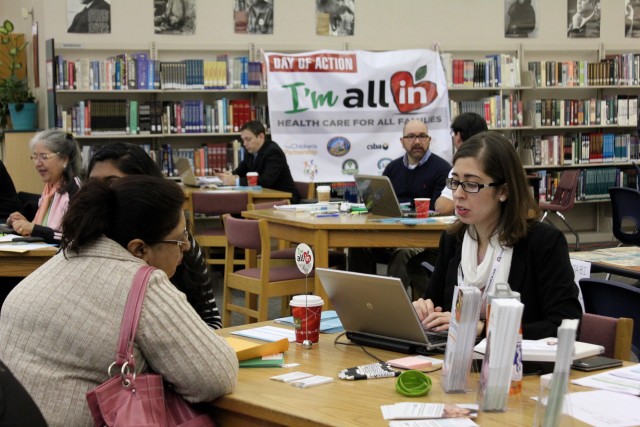Papas is working with Covered California, The Children’s Partnership, an advocacy group, and California Coverage & Health Initiatives, a statewide association of affordable insurance outreach groups, to create a sample health care information document for districts to use or modify. “Our goal is to lead families to the most accurate information,” she said.
In the meantime, with the Feb. 15 open-enrollment deadline looming, Natomas High School in Sacramento hosted a Saturday event last month. In the library, families learned how to enroll in health insurance, while in nearby classrooms, parents and students learned how to plan for college. About 70 families showed up. Eighteen enrollment counselors settled their laptops on tables around the library as parents trickled in, many of whom were new to the idea of a health insurance plan.
By the end of the event, 17 families had enrolled in either a Covered California plan or Medi-Cal, the state insurance program for low-income residents, said Carol Williams, with the Natomas Unified School District. All told, in the January event and two other events last year, the district has helped about 100 families sign up for health insurance, she said.
A look at attendance data prompted the district to think about hosting a health care enrollment event, Williams said. “When you see attendance patterns, you have to ask yourself what’s going on –- and do something to address it,” Williams said. “We wanted to make sure that if kids were ill, they could go to a doctor.”
In 2013, more than 650,000 California children were uninsured. While that number has decreased through new enrollments in both Covered California and Medi-Cal since the implementation of the Affordable Care Act a year ago, a more recent count of uninsured children is not yet available.
Schools are a natural partner for efforts to improve student health, advocates said. Schools are funded based on average daily attendance figures, chronic absenteeism is closely tied to the physical and emotional well-being of families, and health insurance is a way to help students get the care they need to be ready to learn.
In addition, districts are now required to include strategies and goals for improving attendance in their three-year planning documents, known as Local Control and Accountability Plans.
“We see this as an ongoing effort to help schools understand that healthy kids make better students,” said Wendy Lazarus, co-president of The Children’s Partnership. “Health coverage assistance is one way to start.”
As school districts prepare for the kick-off of kindergarten enrollment next month, the California Department of Education is hustling to prepare a two-sided sheet of health coverage information. The new law requires the department to create a sample document by Aug. 1, but Papas said the materials will be ready before then. Additionally, the department intends to post online various tools for districts, including a sample blurb about finding health coverage options that districts could include in newsletters.
The key information for families, Papas said, is how to contact Covered California or find a Covered California enrollment event, where families can meet in person with counselors, speak confidentially and find out if they qualify for a subsidized health care plan or Medi-Cal. Undocumented residents are not eligible for Covered California health plans or Medi-Cal, but some counties do provide health care services for them.
In the meantime, more school presentations are planned by the All In Campaign and Covered California, including enrollment events at Woodrow Wilson Elementary in San Mateo C0unty, the Hesperia Unified Parent Resource Center in San Bernardino County and Eastman Elementary in Los Angeles County.
